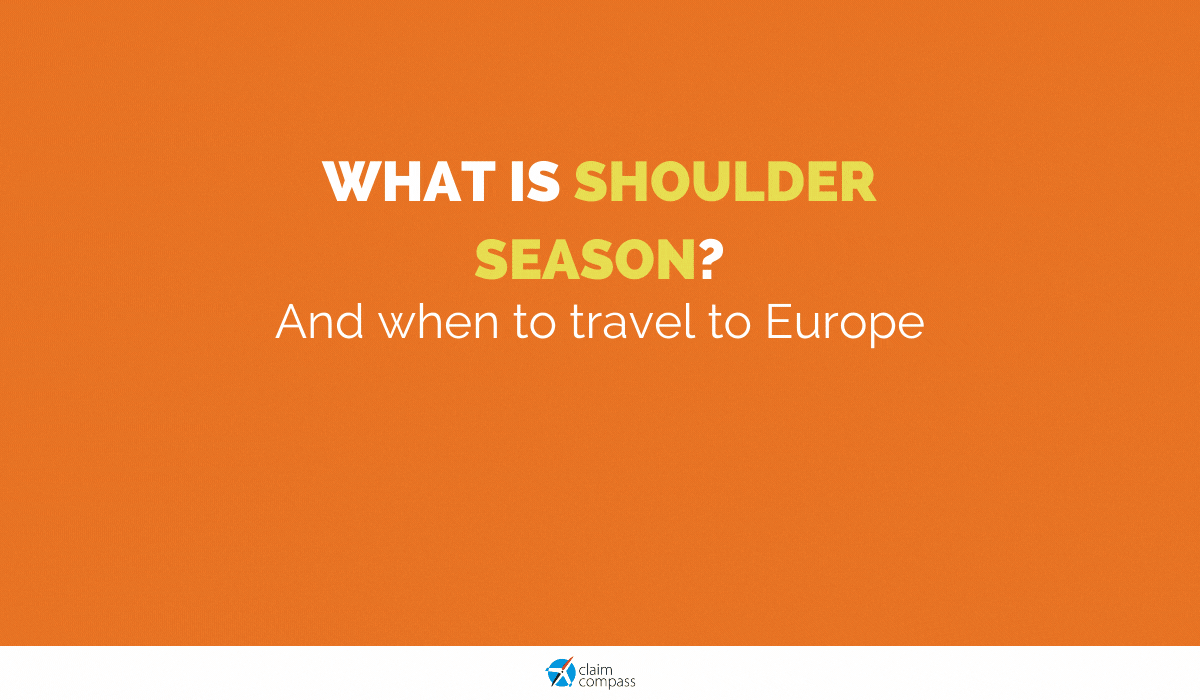What is Shoulder Season (and When to Travel to Europe)?
You wonder when and what is shoulder season? This post tells you everything you need to know about this expression from the travel industry jargon.

Have you ever heard the expression “shoulder season” and wondered what it meant?
In this post, we’re telling you everything there is to know about shoulder season and why it’s the best time to travel to Europe (and most destinations).
What is shoulder season?
The meaning of the term is not intuitive, to say the least. So what does shoulder season mean?
It’s the travel period between peak and off-peak season. Put another way, shoulder season is the time of the year in between the low and high seasons for a particular destination.
As a rule of thumb, shoulder seasons are spring and fall.
Why should you pay attention to when the shoulder season in your destination is?
Because that’s when prices in the tourism industry are at their cheapest: airfare will be considerably less expensive and accommodation (hotel or not) much cheaper. Not to mention, crowds are usually much smaller, if present at all.
By opposition, during peak summer time and the Christmas holidays, the travel industry significantly increases its prices, because flights and hotels are in higher demand.
Shoulder Season Travel: What is considered shoulder season?
What are shoulder months?
The same way that shoulder season is the time of year between the high and low season, in the travel industry, shoulder months are the months at the beginning and end of the high, or peak season.
Shoulder months vary from one location to another, but at least in the northern hemisphere, shoulder months are May-June and September-October, as those respectively come before and after peak summer time.
What is shoulder season in Europe?
Depending on where you’re heading exactly, Europe can be quite pricey. Shoulder season is the best time to visit Europe.
In short, summer and winter are peak travel times and the busiest times of year in Europe: tourists flock from everywhere and as a result, prices increase. That’s because Europe is a popular destination in the summer for those seeking to enjoy the beach, while December to February attracts travellers seeking the thrills of the Old Continent’s ski slopes.
This creates two shoulder seasons in Europe:
- Late april to early June
- September to November
Those are the best time of year to visit Europe because they combine fewer crowds, lower prices, and relatively warm temperatures (depending and precisely where you’re travelling to). Great weather is not guaranteed, especially during fall shoulder season, but early fall around the Mediterranean (south of France, Italy, Greece) are your best bet if you’re really allergic to cold temperatures.
What is shoulder season in Australia?
Australia is a huge country, with very different climates depending on the location. Shoulder season in Australia might vary based on your specific destination there.
The best time to visit Southern Australia would be between April and May or September and November. March would still be okay, but it’s not exactly a shoulder month - and it’s a terrible time or year to visit the northern part of the country, because that’s the wet, hurricane season.
To visit this northern, tropical region of Australia, your best bet is rather what constitutes peak season in Europe: June, July, and August.
So, if your plan is to head to the south of Australia, Kangaroo Island, Tasmania, or New Zealand, plan a trip between March and May. If you’d rather head to northern or central Australia instead, leave between June and August.
What is shoulder season in Bali?
The shoulder season in Bali is arguably shorter than in Australia: April and May are the safest shoulder months, while September and October are riskier. Why?
Because fall precedes the rainy season in Bali and you’re more likely to get wet. From November until March, Bali is less expensive, but the rains will dampen your mood.
Keep in mind that Bali is likely to be busy, no matter when you go there, but crowds are at their worst when temperatures get warmer and the sun shines.
What is shoulder season in the Caribbean?
Similarly, the Caribbean’s shoulder season starts after Easter, late spring. Peak months are the summer months, while fall can be considered the region’s second shoulder season.
Why is it called shoulder season?
The first use of shoulder season was recorded in the 1960s.
Honestly, there is no definitive explanation as to why it’s called like this, but a few explanations are possible.
One of them, perhaps the most probable, is that in spring and fall, temperatures are not as cold as in the winter, so people don’t wear sweaters. But it’s not as hot as in the summer either, so they can’t just wear a t-shirt either. They usually wear a scarf, shawl, or other kind of wrap on their shoulders… hence, “shoulder season”.
Another could be that shoulder season is called like so by opposition to the “head seasons”, which would be summer and winter. Spring and fall, as they occur before and after summer and winter (on each side of them), are what the shoulders are to the head, located on each side of it.
Bottom line, you can thank the tourism industry for yet another inexplicable term!
Why you should travel during shoulder season to Europe
1. Off-season deals save you a lot of money
Travel deals are more frequent during shoulder months, because most popular destinations that live off tourism try to attract travellers to survive. To do that, they set lower prices that allow you to save money on fares, hotel accommodation, etc. Those shoulder season deals can truly help you save a fortune on your trip.
2. Fewer people will be around to bother you
Let’s be honest: crowds suck.
No matter how sociable you are, the fewer people at your destination, the better. The absence of crowds makes it easier to move around and you don’t need to wait as much. Your pictures are also less likely to be ruined by a multitude of strangers.
3. The weather is mild
The main reason why summer is the most favored travel season is the weather: it’s warm and sunny, perfect to go to the beach.
But most people are oblivious to the fact that temperatures in late spring and early fall are sometimes just as warm as in the summer. At the very least, they are mild enough for you to enjoy the beach. If that’s what you want to do with your vacation days.
If you’re not travelling to go to the beach, then shoulder season in Europe is an even better option, as you won’t be too warm when wandering around or going on a hike.
Not to mention that spring is perhaps the time of year when Europe is at its prettiest, with the blooming flora announcing warmer days to come.
In any case, shoulder season is usually great for some outdoor time, which yields most of travel's benefits.
So there you have it! You’re now an expert on shoulder season and know why it’s the best period to travel to Europe (but not only).
Don’t forget that if your flight is delayed or canceled on the way there or when you come back home, you could get compensation from the airline!
